
And they read from the book, from the law of God, translating to give the sense so that they understood the reading. Nehemiah 8:8 (NASB)
Path To Spiritual Growth
One day John realized that what he knew about the Bible had come from his pastor. He was having a discussion with some close, dear friends. As they talked about God and about the Bible, he realized he could not go to the Bible and find what he believed. He realized that he could not find the answers for himself. He did not know where the Bible talked about Jesus Christ, salvation, heaven, hell, church conduct, or just about anything else. He discovered that he needed to know the Bible for himself. What if his pastors were wrong? So he decided to study the Bible for himself.
Later he read 1 John 2:12-14 and found that spiritual growth was not determined by how long a person was a Christian or the age of the person but by the depth of one’s relationship with God. He discovered that 1 John 2:12-14 says that a believer might be a spiritual child, a spiritual young man, or a spiritual father. A new Christian starts as a spiritual child. He or she knows God the Father in an elementary sense, and that his or her sins are forgiven. A spiritual young man is strong in the faith (Romans 4:20), is learning more and more of the Bible, and is having victory over sin. This believer is sinning less and less (Romans 8:13-14). A spiritual father in the faith is more than a spiritual young man. The only thing we are told about him is that he knows Him who is from the beginning.
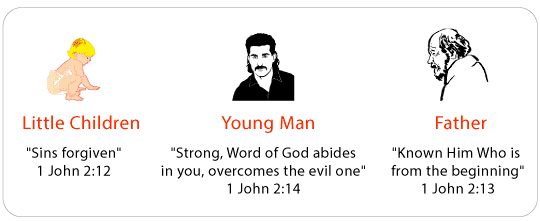
Moses was a spiritual father. This is obvious from Exodus 33:13-16 because He longed to know God. He longed to see God. He wanted a deep relationship with God. As you read the passage, remember that Moses had already in the power of God performed many awesome and incredible miracles. God had brought plagues on the Egyptians through Moses. Moses had brought Israel across the Red Sea and provided them water from rocks. Moses was God’s minister of at least two million people. Yet Moses wanted something more. Listen to Moses as he asks God for a favor,
Now therefore, I pray Thee, if I have found favor in Thy sight, let me know Thy ways, that I may know Thee . . . Exodus 33:13 (NASB)
Moses wanted to know more than just some facts about God. He wanted to know God – really know God! That is the heart’s desire of a father of the faith. A father of the faith is not happy with simply knowing the Bible. Every Christian must know the Bible in order to really know God – to become a spiritual father. That is the message of 1 John 2:12-14. But the goal is not to know the Bible. The real goal is to move to know God. What does 1 John 2:12-14 require in order to be a spiritual father?
What does Psalm 103:7 say that God did for the Israelites, and what did He do for Moses?
The acts of God are things that He has done. We read about them in the stories about Adam, Enoch, Noah, Abraham, Joshua, Gideon, Samson, King David, Daniel, and Elijah, for example. But God did not help the Israelites to know His ways in a personal way, but did help Moses. Why? The answer is found in what Moses was seeking. Jeremiah 29:13-14 gives us the answer. What is the answer according to this passage?
Whom does God reward according to Jeremiah 9:23-24 and Hebrews 11:5-6?
Becoming A Spiritual Young Man
We have already discovered that a Christian begins as a spiritual child. In order to become a spiritual young man, a believer must grow in faith, strive to be victorious over Satan, and study the Word of God. So, what is the goal of Bible study? Fill out the table below and explain what is the correct purpose of Bible study.
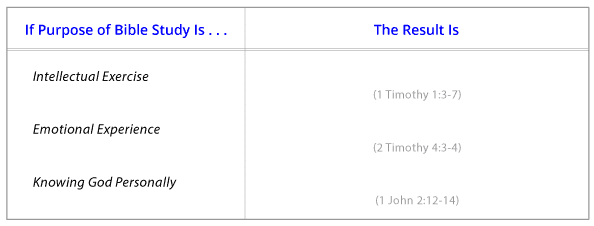
There are other reasons for studying the Bible. What are these other reasons?

Prepare To Study
In order for believers to learn the Bible, they need the Holy Spirit to teach them. 1 Corinthians 2:9-10 says that we cannot really understand the Bible without the Holy Spirit’s help. So we must start by asking the Holy Spirit to teach us as we read or study the Bible. But our sins can hinder us from having the help of the Holy Spirit. What do the following verses reveal that hinder us from learning about the Bible?
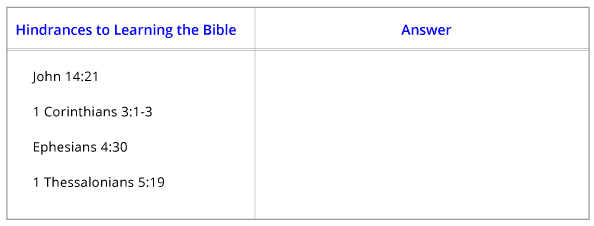
We must come with the right purpose and proper attitude. Our goal in Bible study must be to know our Creator and to love Him. The response of your heart should be to please Him and enjoy Him (Hebrews 11:5-6).
The next step is that you must pray, asking God to help you study the Bible (Ephesians 6:18; 1 Thessalonians 5:17). Then find a place where you can study. Then work hard in the study of the Bible. That is the message of 2 Timothy 2:15. When you study the Bible, study the Bible. Remember you have come to learn about God first and then about yourself.
How The Saints Studied The Bible
The Old and New Testament saints show us how to study the Bible. There are three examples we want to examine. The first and second examples are Ezra 7:10 and Nehemiah 8:2-9. What do the following passages tell us about how to study the Bible?

The third example is found in 1 Timothy 4:13. Here the apostle Paul tells Timothy to give attention to reading, exhortation and doctrine. So they read the Bible, gave the sense or meaning of the passage, and then they applied it for the people, so that the people would respond positively to the Word of God. These passages teach us that there are three steps involved in studying the Bible. These steps can be remembered by using the acronym SMA. It stands for “What does it say?” “What does it mean?” and “How does it apply?”
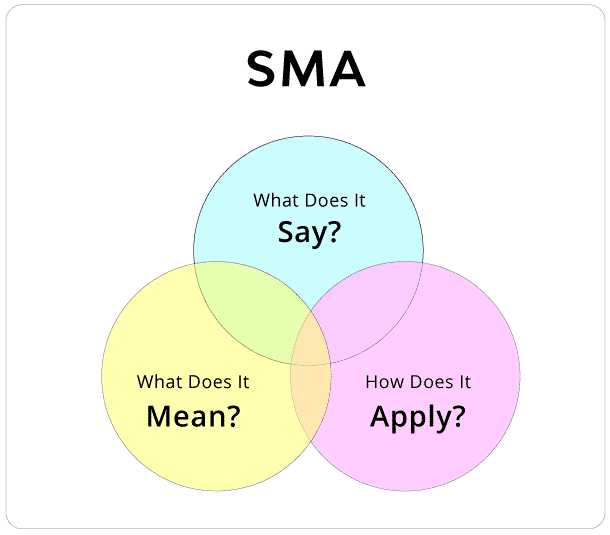
What Does It Say?
When we study the Bible, we must first discover what does it say. This requires that we read the passage at least four times.

First Reading
The first time we read the verse or passage, we want to understand the big picture. In fact, we should read it many times until we can close our eyes and remember what happens step by step. We want to start by understanding the big picture and eventually everything that is happening. It would be good to read the context, that is, the chapters that come before and after the passage we are studying. If possible read the entire book.
But there is an issue that we have not discussed yet. The issue is which Bible should you read? There are many Bibles that can be purchased and that are being published each year. There are two basic types of Bibles that can be purchased.
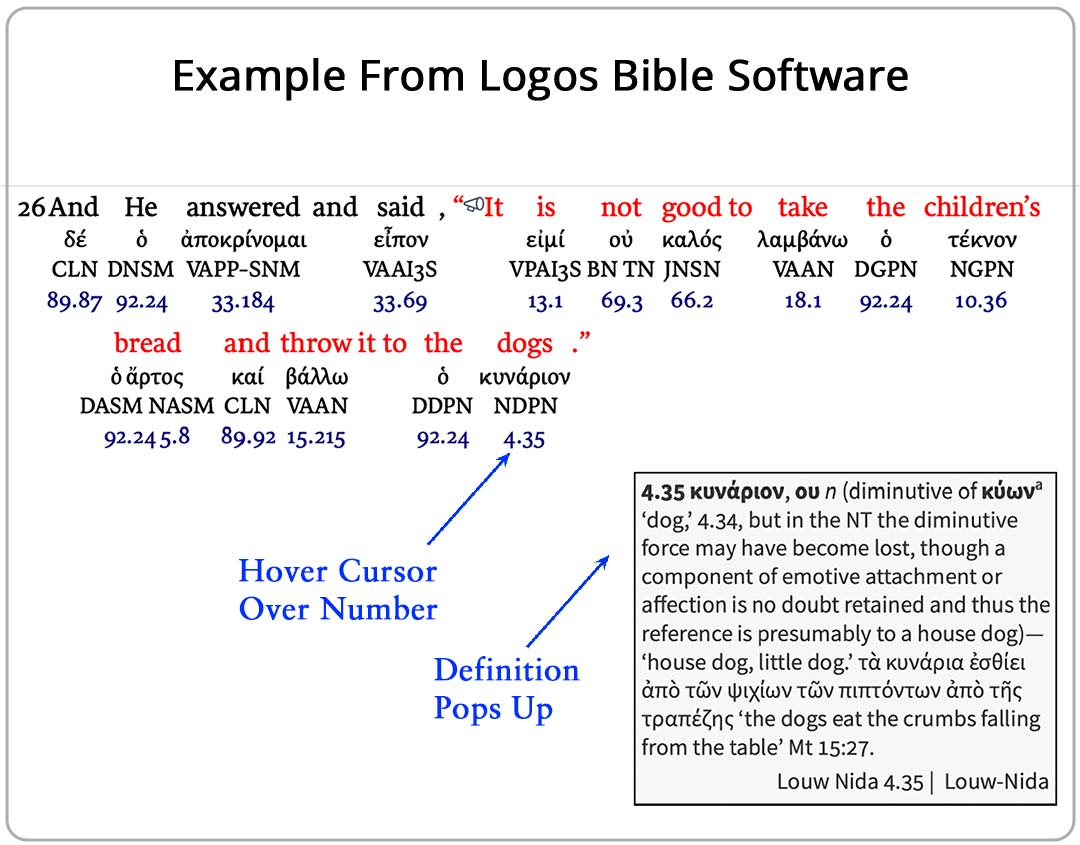
Dynamic Equivalence Translations. The first type of Bible is called dynamic equivalence Bible translations. This type of Bible is a thought-for-thought translation. This means the Bible translators have not attempted to provide a word-or-word translation. Instead, they have combined words, and also added words that do not exist in the original Hebrew, Greek, and Aramaic. An example of this type of translation can be found in how the New International Version (NIV) translated Acts 14:23. When you compare the NIV’s translation to a literal translation of the original Greek, you would discover that the NIV has added the phrase “Paul and Barnabas.” Here is the NIV’s translation of the verse.
Paul and Barnabas appointed elders for them in each church and, with prayer and fasting, committed them to the Lord, in whom they had put their trust. Acts 14:23 (NIV)
This means the NIV is more like a commentary than a true translation. Another issue this raises is, what else did they add to other verses that the reader does not know about? The New International Version Bible (NIV), Amplified Bible, and the Passion Bible are dynamic equivalence Bible translations.
Formal Equivalence Translations. The second type of Bible is called formal equivalence translations. These Bibles strive for an accurate word-for-word translation of the original Hebrew, Greek, and Aramaic. This is a great advantage for those who do not know how to read these languages. The drawback for some people with this type of Bible is that it may be more difficult to read. The New American Standard Bible (NASB) is an example of this type of Bible. Here is the NASB’s translation of Acts 14:23.
When they had appointed elders for them in every church, having prayed with fasting, they commended them to the Lord in whom they had believed. Acts 14:23 (NASB)
Now compare the translations of the NIV and the NASB. What differences can you find?
Other types of formal equivalence translations are the King James Bible translation (KJV), the English Standard Bible (ESV), and the more recently published Legacy Standard Bible (LSB). This means that the best Bibles we should use for Bible study, if you do not know the original languages, are formal equivalence translations.
Second Reading
When we read the passage the second time, we need to ask a variety of questions to help us understand what the passage is saying. One question is, “Who is mentioned in the passage?” Other questions are, “What happened? When did it happen? Where did it happen? Who said so? To whom is the passage written? What happened and to whom did it happen? ” Questions such as why and how usually cannot be answered until later in your study. These questions help you start to understand the passage. As you read and answer the questions, write out your answers on a sheet of paper. At this point you are collecting pieces of information. The pieces of information are like pieces of a puzzle. Later you will want to put the puzzle together.

Third Reading
The third time we read the passage, we should look for key words such as nouns and verbs. Nouns usually refer to people, cities, countries, towns, and buildings that are important to understand. When we understand who the ancient people were, the location of places, and the hour of a day, and other important information, we can better understand what is happening in the passage. The verbs give us the action and help us discover what is occurring.
Bible software is recommended to help the non-Greek reader have a basic understanding of the meaning of the nouns and verbs. A good Bible software application will allow the serious Bible student to purchase the Louw and Nida lexicon. Remember that the goal of the third reading is to collect information about the words, and phrases.
Fourth Reading
During the fourth reading, we want to take all of the pieces of information and put the picture together. As we do this, we want to discover the meaning of the passage. At this point, we need to read some commentaries to collect the views of other people. If we buy books, we need to obtain recommendations so that we will learn from authors who truly believe that God wrote the Bible, that it is authoritative, and without error. We want to be sure the author is highly recommended. There is a list of recommended books at the end of this study that can help your study.
What Does It Mean?
During the fourth reading, we want to follow ten principles that will help us understand the meaning as we put the picture together.
-
Understand Scripture literally, unless it is clear that it is figurative.
This principle simply means that we must understand scripture literally, unless it is clear that our passage is figurative. Most prophecies are literal, even when they use figurative language, because the symbols are defined in Scripture.
-
Use other Scriptural passages to help you understand the passage.
This principle means we need to search for any other passages in the Bible that will help us understand the verse or passage we are studying. The passage may add new information or appear to disagree. If it appears to disagree, that means we do not understand something correctly. We must remember that the Bible will not contradict itself since God, Who does not lie, wrote all of the Bible.
-
The context may affect your understanding of the passage.
This principle states that the context may affect our understanding of the passage we are studying. Therefore, we need to read what came before and what follows the verse or passage we are studying.
-
Avoid proof texting (a series of verses that do not actually prove your point).
The principle warns us against using Scripture verses that do not mean what we say they mean. We must be careful to not incorrectly understand a passage or verse.
-
Let Scripture interpret Scripture.
This principle states that we can use other Scriptures to help us understand the Scripture because the Holy Spirit has written every word of Scripture. He has not explained everything about a topic in just one place. For example, He has explained prayer in Matthew 6:9-15 and in many other places (John 14:13; 15:7; Ephesians 6:18-19; 1 Thessalonians 5:17; 1 John 3:22).
-
Scripture does not contradict Scripture.
This principle reminds us that Scripture cannot contradict Scripture. Why? Once again, the answer is that the Holy Spirit wrote all the Bible. He never contradicts Himself because He is perfect.
-
Obscure passages must give way to clear ones.
The next principle warns us against using obscure passages, such as 1 Corinthians 15:29, to establish doctrine.
-
If Scripture has not spoken, we are wisest to be silent.
This principle is violated often. That is, if the Scripture does not reveal some information, then we must avoid making dogmatic statements. When Scripture does not tell us something, our best guess about what might be true may be wrong.
-
Scripture is the only certain source of truth – not our experience or science.
This principle is also often violated. That is, science and experience does not determine truth. We must remember that God does not lie and the Holy Spirit wrote all of Scripture. When Scripture and science or our experience disagree, then Scripture must always win! God wrote it!
-
Be teachable…be willing to reconsider what you believe!
The final principle is a reminder that you must be willing to learn as you study. This may mean changing what you believe if you want to know the truth and glorify our God.
How Does It Apply?
The last letter in the acronym, SMA, is “A”. It stands for “How does it apply?” Application can be a wonderful part of Bible study. It is here we discover how we should respond to the Scripture in order to be like God. We find victory over sin and our problems. We discover the purpose of trials. We find sins in our lives that God wants us to remove, and God gives us direction for life. If there is a command to action, the application is easy; we ought to obey. If there is a warning to avoid something or an encouragement about an attitude, then we should comply in order to realize the benefit.
But best of all, we discover new glimpses of God. In Hebrews 2:17, we discover that we are sinners and need His forgiveness. We discover that He was made like us and calls us brethren. That implies that He is not distant but is close to us. The word “merciful” implies that He loves us and has great compassion for us. Wow! Does it get any better than this? What else can you find?
At this point, we have put all of the pieces of the puzzle together. The picture is complete. We understand the picture if we have been faithful in our study. So, here are some principles that will guide you in the discovery of the application.
-
Scripture has only one meaning but can have numerous applications.
The first principle for determining the application is that Scripture has only one meaning but can have many applications. Scripture does not have many meanings. Just as different parts of the picture may lock together beautifully and be attractive, different parts of a passage may have special meaning for application to different individuals.
-
Let Scripture be its own blessing, do not spiritualize!
The next principle for determining applications is that Scripture should be its own blessing. Sadly, this happens too infrequently. Too often, teachers desperately want to be emotionally thrilled with a passage of Scripture, so they create an application. Spiritualization of Scripture distorts the true meaning of Scripture. Let the Holy Spirit apply the Word to individual hearts.
-
Avoid applying biblical promises given to Israel to another country.
This principle means that we must not take promises given to Israel and apply them to another country or to all individuals. 2 Chronicles 7:14 is a common violation of this principle. This passage gave a promise to Israel. It does not apply to the United States of America, or any other country. But Jeremiah 18:7-10 does.
-
Avoid forcing Scripture to fit our culture.
This principle means that we must not change the meaning of Scripture to make it fit with or agree with our culture.
At this point, we have discovered how to approach the study of the Bible. The treasure that you find in the pages of Scripture will depend upon how faithful you are in your study. May the Lord bless you as you study.
Things To Ponder
1. What is the focus of the Old and New Testaments according to 1 Peter 1:10-12 and Luke 24:27, 44?
2. Why should we study the Bible according to Exodus 33:13 and 1 John 2:12-14?
3. Can a person really know God without knowing the Bible?
4. Does every book of the Bible reveal something about God? Why?
5. According to 1 Corinthians 8:1, what can happen if we study the Bible for the wrong reason?
6. According to Hosea 4:6 and Hebrews 5:11-14, what happens to us if we do not study?
7. Revelation 1:3 and Nehemiah 8:8-9 give us three things we should do with God’s Word. What are they?
8. What is the best way to remember God’s Word and apply it to your life (see Deuteronomy 11:18)?
9. Some people study the Bible to find proof of something they want to be true. So they search and search the Bible and twist the meaning of a Bible verse to make it say what they want. What kind of person does this according to 2 Peter 3:16?
10. What promises are made to those who meditate on God’s Word (Psalms. 1:2-3)? 11. If you want to know God more, how do you plan to accomplish your desire?
Basic Bible Study Tools
The following Bible study tools are highly recommended for Bible study. They are among the best that are available in 2022.
Bible Atlas
The following Bible atlases are highly recommended. The Satellite Bible Atlas by William Schlegel is an atlas which provides electronic versions of the maps.
Bible Commentaries
Quality Bible commentaries can be difficult to choose because so many are written by liberal theologians, men who have a low view of the Bible. Caution is advised when you buy any commentary. Therefore, we are highly recommending the following commentaries:
Single or Two-Volume Sets
Multi-Volume Sets
Bible Dictionaries
Some of these books are really encyclopedias. They help the student investigate the meaning of names, provide information on geographical locations, determine the significance of ancient customs and cities and historical events. The New Unger’s Bible Dictionary is best one currently available. Three works are suggested:
Bible Software
There are a number of excellent Bible software products available. The following software products are highly recommended. Logos Bible Software is the best one available.
Concordances
Concordances are useful for finding verses related to a word and helping us find the meaning of a word. Many Bibles have short concordances. A concordance is a list of words followed by a list of verses in which the word occurs. A concordance can help you find a verse(s) if you can remember a word or words in the verse. This requires that you know at least one of the words in the verse. Some concordances will help you find the meaning of words. Four very good concordances are suggested:
Cross References & Topical Helps
Topical studies are great. But finding passages and verses on a special subject or topic can be difficult at times. The New Treasury of Scripture Knowledge provides Bible references from other passages that help you understand the passage you are studying. It is a unique and invaluable book. The MacArthur Topical Bible is a great complement, providing references that often are not included in The New Treasury of Scripture Knowledge. Nave’s Topical Bible by Orville Nave is topical rather than verse-by-verse. Here are the recommendations:
Hebrew and Greek Word Dictionaries
Word dictionaries are used to determine the original meaning of individual Hebrew and Greek words. Sometimes background information is provided about the word. Vine’s Expository Dictionary of Old And New Testament Words is easier to use since it lists the English words used in the KJV Bible alphabetically and then provides a list of the Hebrew or Greek words which have been translated as that word. For example, under the English word “love” three Greek words are listed. One refers to God’s love, another is used for brotherly love, and the last is friendship love. The first three books below are for the Greek reader. The following are suggested:
Jewish Background
These books typically have lengthy discussions on historical, geographical and cultural background information. The Life and Times of Jesus the Messiah is highly recommended since it contains a wealth of information about Jesus and the people of His time. It is written by a converted Jewish rabbi. Several suggested books are as follows:
Systematic Theologies
These books will help ground you in the Scriptures. This is the initial place to start learning the Scriptures. The best systematic theology available today is Biblical Doctrine by John MacArthur and Richard Mayhue. The next one is Evangelical Theology. It is highly recommended because of its brief survey of the major spiritual doctrines. It also provides a short historical survey of each doctrine. Grudem’s Systematic Theology is very comprehensive and easy to read. His Bible Doctrine is an overview of theology.
Suggested Links:
How To Study the Bible (9 part series)Preparing to Study the Bible, part 2 — avoiding errors in interpretation
What Does The Bible Say? — example of observing
Discovering the Meaning of Scripture — principles of interpretation
How to Apply the Meaning — principles to discover the application
Solid Roots Discipleship Series
What Is The Bible? – revelation, inspiration, and inerrancy
Overview of the Books of the Bible – themes and descriptions
What guidelines should be followed in leading a Bible study?
Why is the Bible at times difficult to understand?